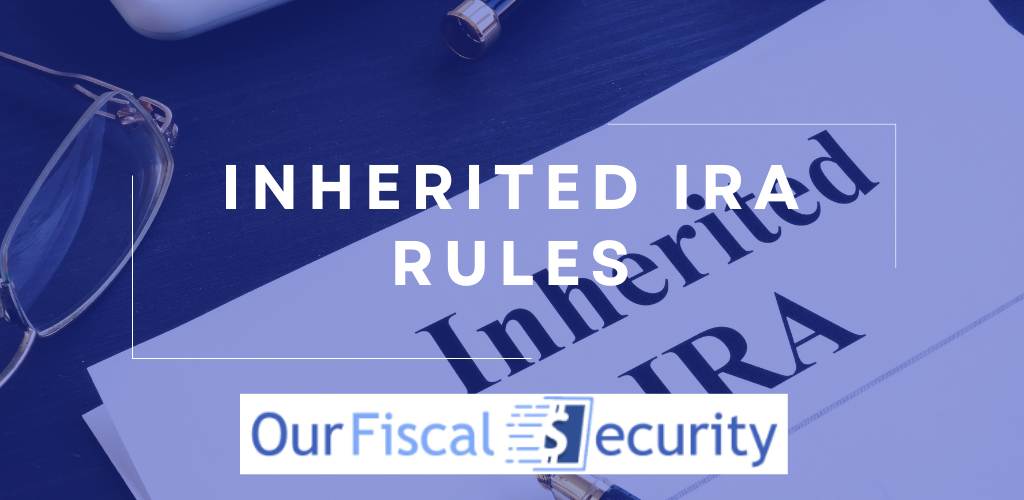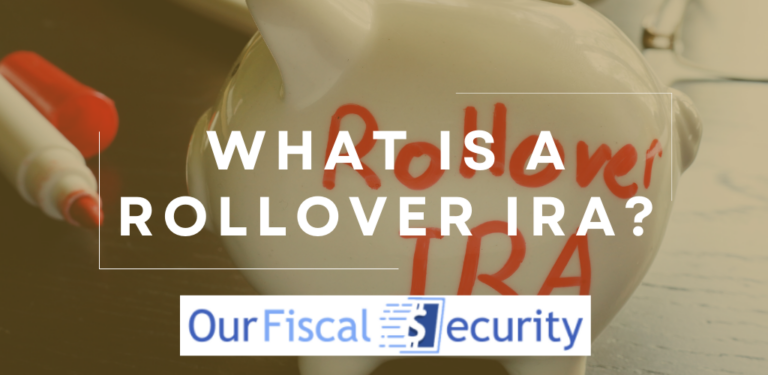Inherited IRA Rules
When a loved one passes away, and you are the beneficiary of their retirement account, you might wonder what this kind of IRA is and how it works. Complying with the relevant acts and regulations is important when dealing with an Inherited IRA, so to ensure that you have access to all the information you need, we have drawn up this comprehensive guide.
Here, we’ll provide a definition of the term “Inherited IRAs,” cover the basics and take an in-depth look at the SECURE and SECURE 2.0 Act.
Understanding Inherited IRAs
Before we get into the gory details, let’s first ensure that you understand what an Inherited IRA is and how it works.
Definition of an Inherited IRA
An Inherited IRA is an individual retirement account which is left to a loved one when a person passes away. The beneficiary can be a trust, spouse, or another family member, and the rules regulating Inherited IRAs differ according to the relationship between the person who passed away and the beneficiary.
Generally, non-spouse beneficiaries have to start taking distributions from the IRA, with the payment schedule determined by the deceased’s age at the time of their passing. Spousal beneficiaries, on the other hand, can treat the Inherited IRA as their own or follow certain guidelines.
Inherited IRAs may provide tax benefits, but understanding and following the applicable requirements is critical to maximizing the advantages that they offer.
Traditional IRAs vs. Roth IRAs
The differences between traditional and Roth IRAs are visible in their tax treatment, and these variations also apply to Inherited IRAs, altering how beneficiaries manage withdrawals and taxes.
Contributions to Traditional IRAs are made using before-tax money, and withdrawals are subject to taxation as regular income. If inherited, beneficiaries are usually compelled to take the required minimum distributions (RMDs) based on their life expectancy, which are then subjected to taxation.
Roth IRAs, on the other hand, are financed using after-tax earnings and provide for tax-free withdrawals during retirement. If a Roth IRA is inherited, the recipients may be eligible for tax-free distributions, provided the IRA has been around for a minimum of five years.
With Roth IRAs, account holders are not required to take RMDs throughout their lifetime. However, non-spouse beneficiaries are typically obliged to take minimum distributions. It’s also important to note that there are differences in traditional and Roth IRA fees.
The Importance of Required Minimum Distributions (RMDs)
It’s important to know about the required minimum distributions (RMDs) when managing Inherited IRAs since they specify the sum of money that beneficiaries have to withdraw each year to avoid penalties. Non-spouse beneficiaries will have to take RMDs in accordance with their life expectancy, beginning the year after the original account holder’s passing.
Refusal to take withdrawals may result in significant penalties. Understanding and following RMD laws is critical for minimizing tax consequences. Keep in mind that the timing and amount will have an impact on your overall tax strategy, determining whether the distributions are subject to taxes as regular income for Traditional IRAs or possibly tax-free withdrawals for Inherited Roth IRAs.
Impact of the SECURE Act on Inherited IRAs
Now that you know what an Inherited IRA is, it’s time to get into the rules that may apply. The SECURE Act contains the rules that eligible designated beneficiaries must follow, so having an in-depth knowledge of it is crucial.
Introduction to the SECURE Act
The Setting Every Community Up for Retirement Enhancement (SECURE) Act, which was passed in December 2019, significantly altered the laws for Inherited IRAs.
Before it was implemented, beneficiaries could spread out RMDs throughout the course of their lives, allowing them possible tax breaks. However, under the SECURE Act, non-spousal heirs must now distribute the Inherited IRA within a 10-year period.
The amendments made by the SECURE Act are intended to speed up the distribution of these IRAs, affecting beneficiaries’ tax planning strategies and underlining the significance of understanding the current requirements in order to manage inherited IRA distributions efficiently.
The 10-Year Rule Explained
As we have just seen, Inherited IRAs are now subjected to a 10-year period in which the beneficiary must receive all distributions. This shift has significant ramifications for tax planning since heirs may face bigger taxable distributions in a shorter timeframe.
Rather than receive distributions over the course of their lives, beneficiaries are required to receive withdrawals in a 10-year period.
Exceptions to the 10-year Rule
It’s essential to note here that there are exceptions to the 10-year rule, which enable certain eligible designated beneficiaries, such as children, surviving spouses, disabled heirs, and people who are no more than 10 years younger than the initial account holder, to follow the stretch strategy.
Rules for Spouses Inheriting IRAs
The truth is that Inherited IRA rules for spouse and non-spouse beneficiaries differ significantly. In the next two sections, we will talk a little more about the rules for each type of beneficiary, starting with spouses.
The Spousal Transfer Option

The spousal transfer option is a special benefit provided to surviving spouses who inherit an individual retirement account. Unlike non-spouse recipients who are subjected to the SECURE Act’s 10-year rule, surviving spouses are allowed to regard the Inherited IRA as their own.
What this simply means is that they can effortlessly move the funds from the Inherited IRA into their current IRA or roll them over to a new one.
Using the spousal transfer option, a surviving spouse can postpone RMDs until they reach the age of 72, thus enabling continuing tax-deferred growth. This method offers many perks, including possible estate planning advantages and the ability to seamlessly incorporate the Inherited IRA into the beneficiary’s overall retirement plan.
Inherited IRA Options for Spouses: Life Expectancy Method
Spouses who inherit an IRA can also adopt the life expectancy method, which provides a more flexible and possibly tax-friendly strategy.
If a spouse wishes to be considered a designated beneficiary, they may employ the life expectancy method, which involves determining RMDs using their own life expectancy. This technique allows the spouse to spread out withdrawals over an extended period of time, potentially lowering the immediate tax burden while allowing for continuous tax-deferred growth.
However, it is important to remember that RMDs normally commence the year after the original account holder passes away or the year that person would have turned 72. This method offers surviving spouses versatility and an opportunity for better tax preparation.
Inherited IRA Options for Spouses: 10-year Method
Surviving spouses can also choose to employ the 10-year method, a feature included by the SECURE Act for selected beneficiaries. Although spouses normally have the option of treating the Inherited IRA as their own and deferring distributions until they reach the age of 72, the 10-year method requires a different technique.
Under this system, the surviving spouse is not required to receive annual RMDs according to their own life expectancy. Rather, they can postpone withdrawals until the conclusion of the 10-year period after the original account owner dies. This strategy may provide flexibility in controlling taxable earnings.
Using this approach may be advantageous in cases where postponing payouts is consistent with the surviving spouse’s broader financial plan or tax strategy. However, when dealing with Inherited IRAs, spouses must carefully consider their specific situations and contact a reputable financial advisor to identify the best solution.
The Lump Sum Distribution Option
The lump sum distribution option is one of the options available to spouses who inherit IRAs. When a surviving spouse elects for this alternative, they get the whole amount of the Inherited IRA as a single payment. This option gives the spouse quick access to the money, allowing them to use the financial resources as needed without having to follow a lengthy distribution schedule.
While lump sum distributions can provide financial flexibility, they may have tax ramifications. If the Inherited IRA includes pre-tax contributions and revenue, the entire amount may be taxable as income tax in the year it is acquired.
Rules for Non-Spouses Inheriting IRAs
The truth is that non-spousal beneficiaries are subject to stricter rules. Let’s take a closer look at them in the section below.
Identifying an Eligible Designated Beneficiary
An eligible designated beneficiary is a non-spouse recipient who is eligible for preferential distribution when inheriting an IRA. This covers little children, disabled people, those with chronic illnesses, and beneficiaries who are no more than 10 years younger than the original account holder.
Eligible beneficiaries can apply the life expectancy method, which allows them to extend their RMDs throughout their own life expectancy. This can result in substantial reductions in taxes for non-spousal recipients when compared to the usual 10-year distribution rule.
Inherited IRA Options for Non-Spouses: Life Expectancy Method
As we have just seen, the life expectancy method is available to some eligible designated beneficiaries. When this method is employed, the person’s life expectancy is used to calculate RMDs. This enables a more gradual transfer of acquired assets, possibly minimizing the immediate tax burden and allowing for continuous tax-deferred growth. However, RMDs must begin in the year of death of the initial IRA owner.

Inherited IRA Options for Non-Spouses: 10-Year Method
The SECURE Act frequently requires non-spouse heirs inheriting an IRA to follow the 10-year method. This rule stipulates that the entire IRA will need to be distributed within 10 years of the deceased account owner’s passing.
Unlike the life expectancy method mentioned previously, the 10-year approach lacks the ability to extend payments according to the beneficiary’s life expectancy. However, keep in mind that beneficiaries have the freedom to choose when and how much money to withdraw within a 10-year period, giving them a certain degree of control over tax planning.
Although this alternative offers liquidity and can be useful for controlling taxable income, it may result in a shorter payout term, which could influence your tax bracket. When deciding whether to adopt the 10-year method or not, be sure to consult a financial advisor.
The Lump Sum Distribution Option
This option lets qualifying beneficiaries receive their inherited assets as a single payment. Choosing a lump payment can offer quick access to the funds without having to wait. However, keep in mind that the income received may be subject to taxation, depending on the type of IRA you inherited.
If the Inherited IRA includes contributions made before taxes, you will need to pay taxes on this amount in the year that you receive it. Before choosing this option, it is crucial to carefully consider the immediate need for money versus the tax implications.
Tax Considerations for Inherited IRAs
By now, you probably already know that the tax implications for Inherited IRAs play a major role in the overall experience and the distributions you receive. To ensure that you are making informed decisions about your financial situation, we go into detail regarding taxes and IRAs.
Taxation Rules for Traditional IRAs
The tax treatment of Inherited Traditional IRAs is determined by the deceased’s relationship with the recipient.
If a non-spouse beneficiary inherits a Traditional IRA, they are normally subjected to the SECURE Act regulations, which require that the whole IRA amount be distributed within 10 years. These payments are classified as regular income and could be liable to income tax.
However, as we have already seen, spousal beneficiaries have more options. They can consider the Inherited Traditional IRA as their own and defer their distributions until the age of 72. Alternatively, they can opt to be designated beneficiaries, which allows them to follow certain regulations based on their life expectancy.
Taxation Rules for Roth IRAs
Suppose a spouse acquires an Inherited Roth IRA. In that case, they have the choice of treating it as their own or becoming the designated beneficiary, depending on whether the spouse passed away before or after the required beginning date for RMDs. They will not face any immediate tax implications, and they can maintain tax-free growth for the duration of their lives.
It’s also important to remember that Roth IRAs do not require account holders to take RMDs, so the spouse can choose to retain their earnings for the duration of their lifespan.
However, if the beneficiary is not a spouse, the SECURE Act specifies that they are required to follow a 10-year distribution period. They are not liable to income tax on qualifying distributions, including earnings, because Roth contributions comprise after-tax dollars.
Effective Strategies to Minimize Tax Liability
If you are hoping to reduce your tax liability as the beneficiary of an Inherited IRA, then here are a few tips that you can follow:
- Choose the life expectancy method. This is a great option to choose, if it is available to you, as it allows for more flexible distribution schedules, which lets you enjoy tax-deferred growth.
- Avoid lump sum distributions. If you want to reduce tax implications, then we recommend going for a 10-year distribution instead, as this will allow you to spread out your tax liability.
- Convert your Traditional IRA to a Roth IRA. Consider the possibilities of converting a Traditional Inherited IRA to a Roth IRA. Although this may incur taxes, it could be beneficial if you expect to be in a higher tax bracket in the future or prefer tax-free withdrawals.
- Use your distributions for charitable giving. This approach involves making qualified charitable contributions, which can reduce the amount of tax you pay.
- Seek professional guidance. If you are not a tax expert, then make sure you are consulting one to identify potential ways to save on your taxes.
Managing Your Inherited IRA: A Comprehensive Guide
Now that you understand the tax implications and how to effectively minimize them let’s spend some time talking about effectively managing your Inherited IRA. In this section, we’ll talk about how you can calculate withdrawals, what happens where there are multiple beneficiaries and more.

How to Calculate Withdrawals
Per IRA withdrawal rules, you will need to first identify whether the IRA is a Traditional or Roth IRA if you want to withdraw from an Inherited IRA. Then, consider the beneficiary’s relationship to the original IRA owner.
Under the SECURE Act, non-spouse heirs must determine the payout required to withdraw the full amount during a 10-year timeframe. If eligible, consider adopting the life expectancy method, which spreads payouts over an extended period. Traditional IRA payouts are normally taxable as regular income.
Because the process can be complex, we recommend contacting a financial expert or tax advisor for a more accurate idea of what to expect. Make sure you are staying up to date on any developments that might affect your withdrawals.
Dealing with Multiple Beneficiaries
The truth is that there can be more than one IRA beneficiary. Understandably, this can create a lot of confusion.
When dealing with many recipients, communication and collaboration are critical. Coordinate withdrawal plans, including the life expectancy method for qualified heirs. Promote open communication to ensure that all beneficiaries have common goals and distribution preferences.
In some situations, it may be advantageous to divide the individual retirement account into multiple separate accounts for personal management. When multiple beneficiaries are involved, consulting professionals for specific assistance in navigating complexities becomes critical.
It’s also important to document any agreements to avoid future problems. Customizing the approach to meet each beneficiary’s specific needs creates a unified and effective strategy for administering an Inherited IRA with many recipients.
Understanding the Special IRA Transfer Rule
The Special IRA Transfer Rule allows an eligible spouse who inherits an IRA to effortlessly transfer the funds to their own IRA. Because of the close relationship spouses have, these beneficiaries are afforded more privileges. They can either move the inherited assets into an existing IRA or roll them over into a new account.
This transfer permits the spouse to defer required minimum distributions for Traditional Inherited IRAs until the age of 72, giving them more flexibility.
The spouse can continue enjoying the benefit of tax-deferred growth and even integrate the Inherited IRA into their own retirement plan. Having a good understanding of this rule is important if you are a surviving spouse, as it enables you to better manage your wealth and plan for the future.
Perspectives on Inherited IRAs
By now, you should have a good understanding of how Inherited IRAs work. Before we leave you, we thought it would be beneficial to give you an overview of these individual retirement accounts from several perspectives to gain a better understanding of how they are administered. We’ll look at them from the perspectives of legal, financial advisor, tax advisor, and beneficiary.
Beneficiary’s Perspective: Managing an Inherited IRA
Inheriting an IRA can have important financial implications for the beneficiary. However, it involves making strategic decisions to maximize the financial benefits. Because tax implications play an important role in your overall earnings, it’s important that beneficiaries spend enough time learning more about them through their own research or by contacting a financial professional.
It’s also crucial that beneficiaries determine whether the Inherited IRA is a Traditional or Roth IRA, which will have a bearing on how distributions are taxed. Moreover, the relationship the recipient has with the deceased will also impact the options available to them.
Non-spouse beneficiaries should be aware of the 10-year rule and may be allowed to use the life expectancy method to allow for greater flexibility. If multiple beneficiaries are involved, it’s important to ensure that everyone is on the same page and that agreements are documented.
Tax Advisor’s Perspective: Minimizing Tax Implications
With regard to tax professionals, reducing tax implications on an Inherited IRA is the focus and requires strategic preparation and knowledge of the applicable Inherited IRA rules. Non-spouse beneficiaries will need to have a good understanding of the 10-year rule, while spousal beneficiaries will need to be notified of the other options available to them and the possible tax implications.
Advisors may advocate using the life expectancy method if the heir is eligible, which can help them strategically spread out distributions, reducing the immediate tax burden.
Another option to think about is Roth conversions and their tax ramifications, which might be done over time to manage tax brackets.
Tax professionals may emphasize the need to remain current on modifications to tax legislation that may affect Inherited IRAs and alter plans accordingly. Moreover, tax consultants assist beneficiaries in maximizing withdrawals, claiming applicable tax deductions or credits, and avoiding potential errors that could result in penalties.
Financial Advisor’s Perspective: Maximizing Financial Benefits
A financial expert’s job is to help beneficiaries maximize their monetary rewards with an Inherited IRA. This requires a comprehensive and personalized approach based on the goals and needs of the person involved.
Advisors develop strategies based on the beneficiary’s financial objectives, risk tolerance, and tax status. They advise them on the distribution options available to them, taking into account the 10-year rule and, when appropriate, the life expectancy method.
In addition, these professionals investigate tax-efficient options, such as Roth IRA conversions, and assist beneficiaries in balancing immediate financial demands with long-term goals.
They underline the significance of conducting regular reviews to adjust the person’s approach to changing conditions and shifting tax legislation. It is highly advisable to consult a financial advisor if you have inherited an IRA from your spouse or loved one, as they can help you make informed decisions that are in your best interests.

Legal Perspective: Understanding Legal Obligations and Rights
Beneficiaries need to understand their legal rights and responsibilities in relation to an Inherited IRA. Legal experts help them navigate the complicated acts and rules that they are obligated to abide by, ensuring compliance. Because the recent updates to the SECURE Act have introduced the 10-year rule, understanding the implications is important.
Failure to comply with this rule can have serious consequences. Legal specialists also assist beneficiaries in carrying out any legal duties relating to the deceased’s estate, including drawing up the correct documentation and adhering to any applicable probate regulations.
They offer insight into prospective legal difficulties, such as disputes between different beneficiaries, as well as risk-mitigation techniques. Legal viewpoints on inherited IRAs require a thorough understanding of the legal environment, allowing beneficiaries to make educated decisions and defend their rights while fulfilling their obligations.
Frequently Asked Questions
What are the new rules for inherited IRAs from 2023 onwards?
The new Inherited IRA rules involve taking RMDs within a 10-year period unless you are a spouse of the original account owner and the sole beneficiary of the IRA. The SECURE 2.0 Act got rid of the stretch position, which allowed eligible designated beneficiaries to take distributions throughout the course of their lives, spreading out the tax obligation.
However, according to the new act, only spouses may take advantage of this provision and are allowed to treat the account as their own IRA. Keep in mind that rules and regulations are constantly changing, and remaining up to date on these changes is critical to your success, as non-compliance can have grave consequences.
Do all Inherited IRA funds need to be distributed within 10 years?
No, not all Inherited IRA funds have to be withdrawn in a 10-year period. The 10-year distribution rule, established by the SECURE Act for non-spouse beneficiaries, is applicable in the majority of circumstances.
Surviving spouses and certain qualifying heirs, such as young children, disabled adults, and more, may have additional alternatives. They could also employ the life expectancy method, which allows for greater flexibility and longer payout timelines based on the beneficiary’s life expectancy.
What are the tax implications of an Inherited IRA?
The tax consequences of an Inherited IRA vary depending on a variety of factors, such as the type of IRA (Traditional or Roth IRA), the relationship between the original account owner and the beneficiary, and more.
Keep in mind that the distributions from Traditional Inherited IRAs tend to be taxable as regular income, although those from Inherited Roth IRAs are free of taxes under certain conditions. The time and method of distribution can affect tax liabilities.
This is why it is important to consult a tax professional to ensure that you understand the applicable tax implications.
How can I avoid paying taxes on an Inherited IRA?
While it may not be possible to avoid taxes altogether, you might be able to minimize them. To do so, we recommend spreading out your distributions over time, if possible, or converting the Inherited IRA to a Roth IRA if you are a spouse beneficiary.
Engaging a tax advisor for tailored counsel, researching potential tax credits, and remaining current on tax regulations can all help you improve your approach to reducing your tax burden.
What are the differences between spousal and non-spousal Inherited IRAs?
Spousal Inherited IRAs provide greater freedom by enabling spouses to regard the IRA as their own or select beneficiary options. They may postpone RMDs. Under the SECURE Act, recipients of non-spousal Inherited IRAs are normally required to withdraw funds within 10 years.
Exceptions apply to qualifying designated beneficiaries. Spouses have more alternatives available to them, which might affect the distribution timeline and tax implications, but non-spousal heirs are bound by stricter requirements.
Conclusion
Well, there you have it! We have taken the time to draw up this guide to help you make informed decisions regarding your Inherited IRA. However, keep in mind that this article does not constitute financial advice, so be sure to consult the relevant professionals for tailored solutions that match your risk tolerance and objectives.
If you have inherited IRA assets, you must understand the RMD rules involved. It’s also important to have a comprehensive understanding of the tax implications of inherited Roth IRA and Traditional IRA accounts. Careful financial planning is crucial to ensure that you are choosing a solution that will work best for your unique situation.
This is why we recommend that you consult a reliable financial planner for personalized advice that will help you reach your goals.







